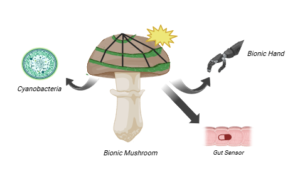Recent news sources have reported bionic mushrooms as a potential renewable energy source. With temperatures on the rise and a growing concern about our natural resources, scientists are searching for renewable energy sources in order to help combat climate change. What these sources fail to recognize, however, is that the ratio of bionic mushrooms needed to generate this type of power may be unrealistic. Specifically, how will bionic mushrooms be useful if it requires seven million of them to generate a single 60-watt light bulb?
The bionic mushroom is an eco-friendly energy source; unlike all other sources of electricity, the bionic mushroom uses natural resources to generate electricity without further contributing to climate change. To understand how the bionic mushroom functions, we need to understand the heavy role cyanobacteria plays within this system. Scientists researched cyanobacteria, a specific type of bacteria that is able to naturally generate electricity by transforming light energy into chemical energy. Cyanobacteria does this through photosynthesis – as light hits the bio ink (cyanobacteria) injected into the mushroom it automatically releases electrons. To implement this process, they landed upon mushrooms as their natural host to contain this bacteria, as other artificial sources were unable to sustain the cyanobacteria for a long period of time. To transform the electrons into an electricity source, scientists have built 3-D graphene nanoribbons that wrap around the mushroom and capture the electrons produced by the cyanobacteria, creating a reliable energy current. Through these combined components of cyanobacteria, 3-D printing, graphene and mushrooms, engineers were able to create bio-electricity.
While the bionic mushroom was an unimaginable feat, readers need to acknowledge that it is not a replacement for general electrical conductors such as windmills, dams, power plants, and copper wiring. Sandeep Joshi, who led a research team on this project, came across the same realization, “To date, Joshi’s group has generated a roughly 70 nanoamp current. That’s small. Really small. It’s about 7-millionth the current needed to power a 60-watt light bulb. So clearly, bionic mushrooms won’t be powering our electronics right away.”

Although bionic mushrooms don’t produce enough electricity to power our homes, they are still a reliable green energy source that could be used to power other biomedical technologies. According to Manu Mannoor, a professor at Stevens Institute of Technology, the energy produced by bionic mushrooms is sufficient for charging medical devices that work in the intestines. Bionic mushroom devices could potentially power pill sensors in the gut, which is helpful for monitoring individuals with gastrointestinal conditions such as inflammation. In a study conducted in 2019, around 2.9 billion individuals worldwide were diagnosed with a gastrointestinal disease. Creating medical devices using energy from mushrooms and cyanobacteria would be a more sustainable option for the environment. Because the bionic mushroom mainly utilizes 3D printing and requires a limited number of supplies, it can be easily manufactured with less waste. Expanding access to ingestible sensors would benefit patients who suffer from chronic symptoms, while also maintaining the health of the environment. Biomedical research on bionic mushrooms could also be applied to other areas of health science, improving our healthcare treatments and preventative measures.
Despite the fact that bionic mushrooms are far from powering homes or even light bulbs, they are still highly beneficial to use in low energy bio-electronic devices. Powering medical devices such as organ sensors could lessen energy waste and aid the environment incrementally over time. While this is an exciting innovation that demonstrates how the mushrooms can work alongside the cyanobacteria to generate electricity, many researchers see this as simply a first step in transforming this energy source into a reliable power source.
Written by: Reema Pedaballi and Sungyu Lim
Edited by: Raeanne Lanphier and Elizabeth Abrash